The special effects in the movie "Mad Max: Fury Road". Part 2/2
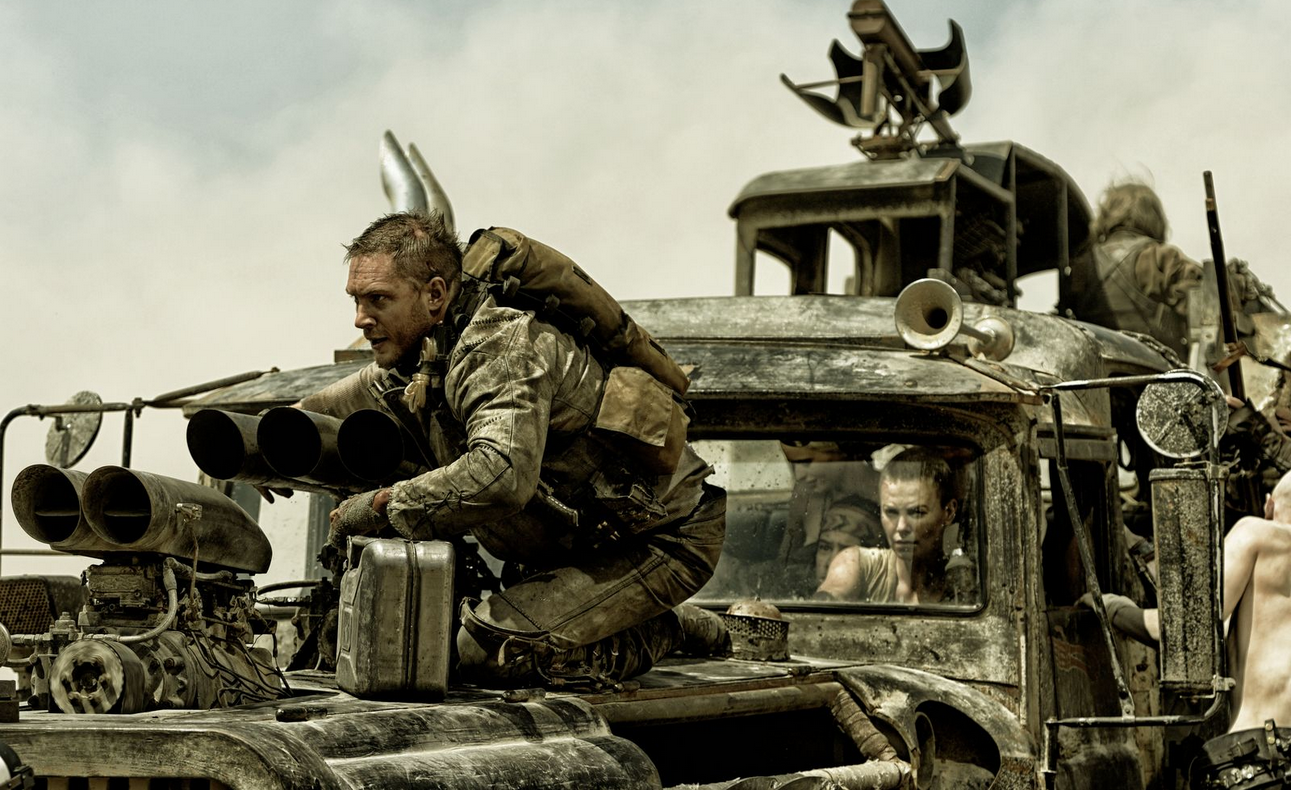
This is the second part of the translation of a large fxguide article on how Mad Max: Fury Road was filmed and what special effects were used to do this. The first part is here .
Crossing a canyon
Iloura and Jackson's Fury FX group were engaged in processing the scene in the canyon, the frames of which required a significant improvement of the environment. “Compared to the location, the final version of the canyon was significantly enhanced,” says Jackson. “The canyon was made significantly higher and narrower than the real terrain. In one of the moments of the film, there is a scene with an explosion of rocks, running through the “arch” above it. So, in reality, such a narrow place with similar rocks does not exist. ”
')
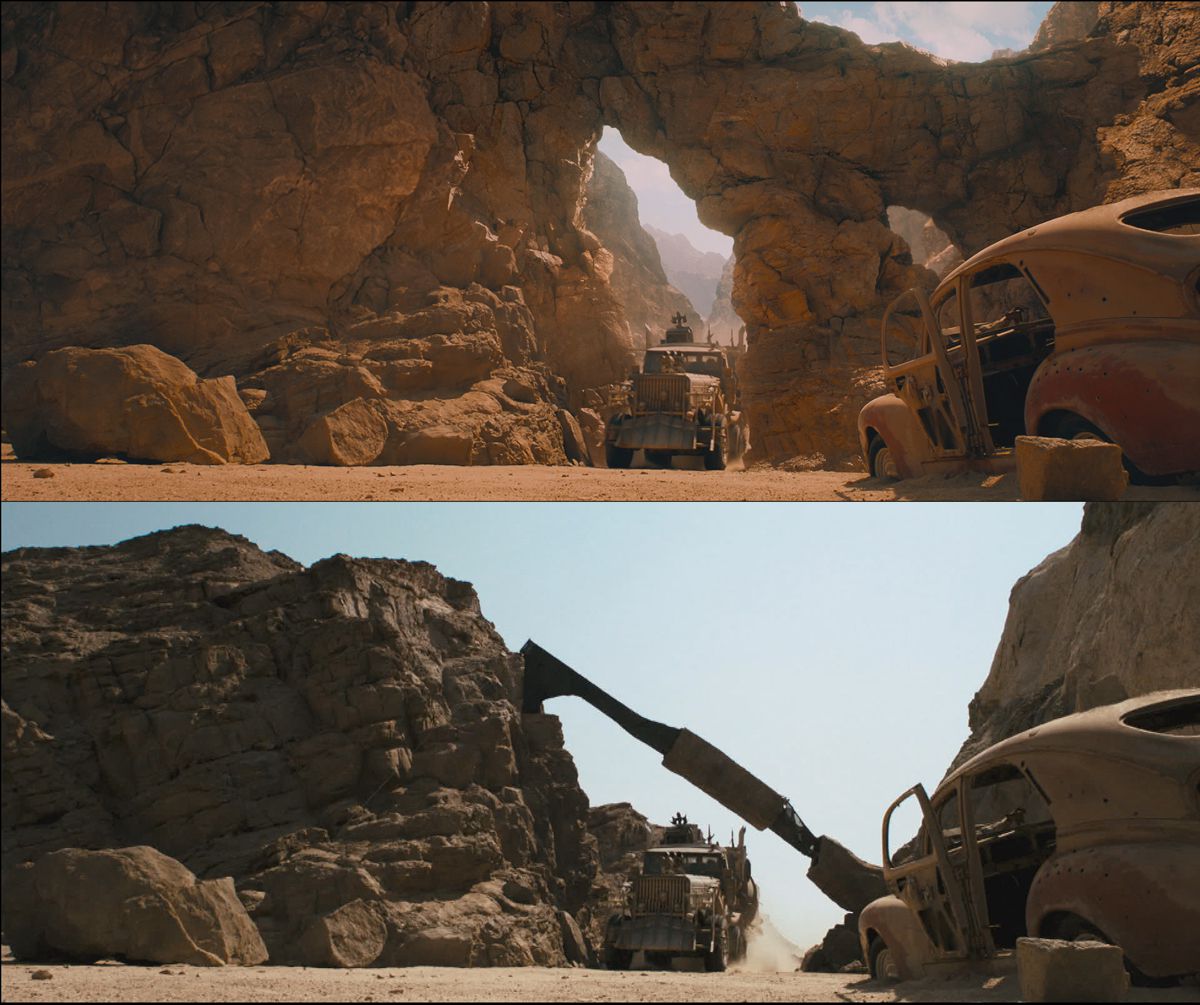
Cinema and reality.
For the explosion of the rock, it was originally planned to use computer graphics, but Jackson said: “I spent too much time explaining to people how to shoot real objects instead of using computer graphics. We began to look for a place where we could blow up some rock in miniature, shooting at close range. As a result, in the area of filming found a career. We asked the owner if we could arrange an explosion in his career, to which he replied: "Yes, of course." We staked out a small area, put cameras on the ground, coordinated all angles and made an explosion. That's how we did. ”
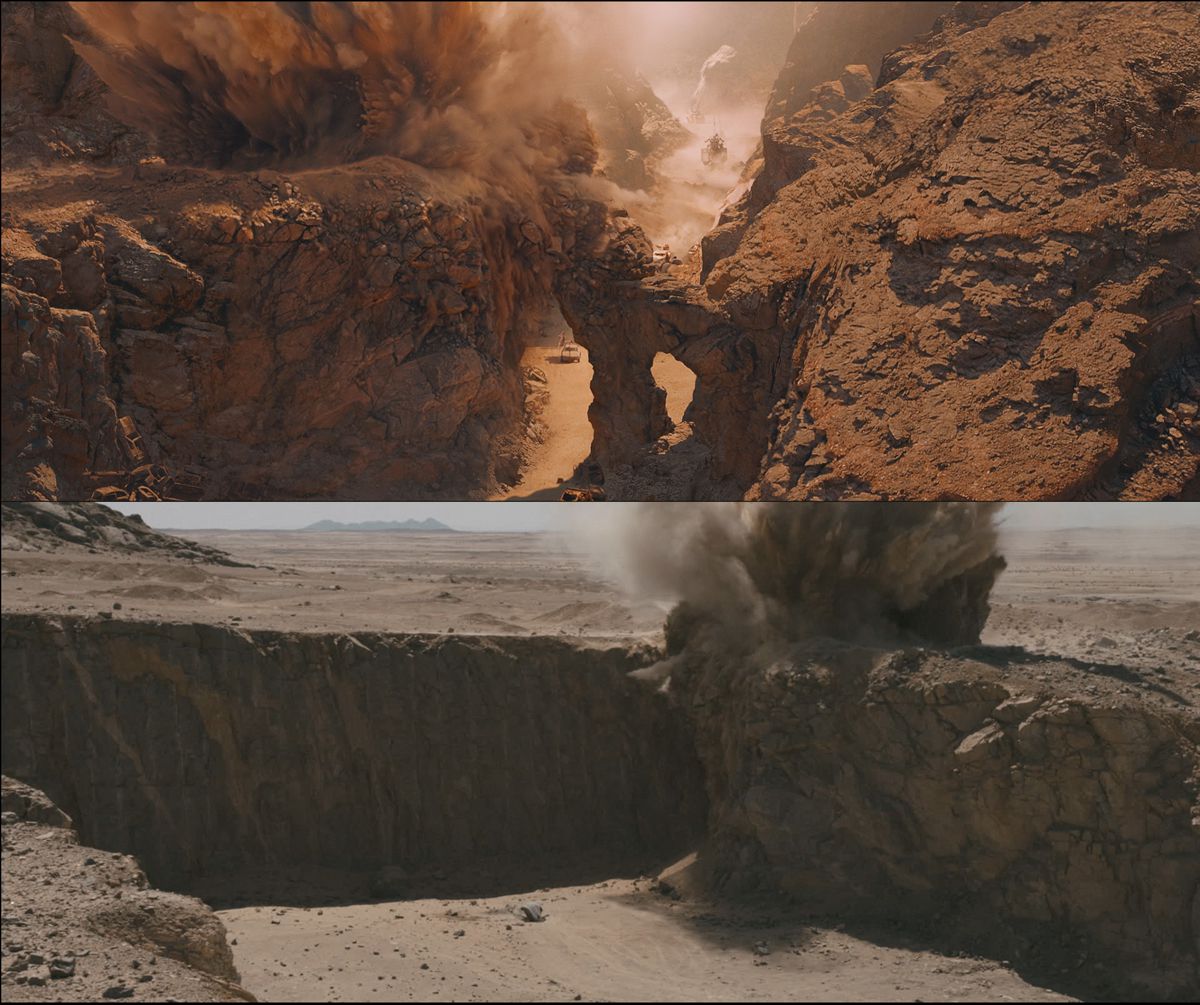
The explosion in the film and career.
Transform day to night
The film has night scenes that were actually filmed in the middle of the Namibian desert in bright daylight. Instead of the traditional dark frames, the night scene of Jackson turned out to be very rich and well distinguishable. The essence of the approach of Jackson was to obtain personnel similar to photographs taken at night with a long exposure. “With the help of Nikon cameras, I can make shots with two, three, four times exposure, which will give the image as good as possible”.
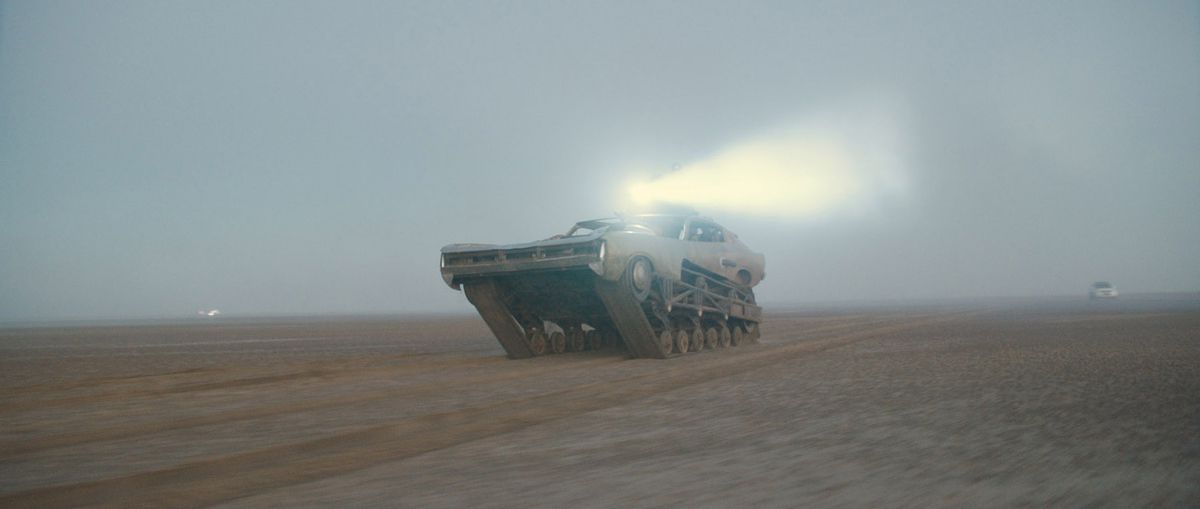
The original shot from the shooting.

Frame from the film after processing and tinting.
Jackson filmed night scenes with an ARRI Alexa digital camera. It was rational, since the overexposed frames contained less noise and transmitted the image in more detail, and when using the Alexa camera, the image did not roll into too bright, “lighted” shots, which later made it possible to turn the material shot in the afternoon into a night scene. “The most important thing that you get from the daytime filming of night scenes is the shadows. Even “turning the day into the night” you keep the detailed arrangement of the shadows that still exist. You can darken the entire image, but the details in the form of shadows will remain, i.e. You do not end up with “black on black.”
Nevertheless, the use of such an approach had to be somehow justified. “I talked with John Sil on this topic and he conducted a series of test shots: in broad daylight in bright sunlight and with the help of ARRI using various exposure settings,” recalls Jackson. “They told me that this is not the most stupid idea and decided to make test shots with two, three and four-time exposure, although they planned only half. I had to work hard to convince them to use the fourfold one - they thought it was just ridiculous. But when we conducted tests and they saw how amazing the obtained material looks, everything was decided right on the spot. ”
Shooting "Gunsmith".
While sorting frames, Hipp used the breadth of Alexa characteristics to turn day to night. “When I started assembling the scene,” Hipp recalls, “I was shocked. To put it bluntly - you have people running around in a frame in full daylight. On the frames there were moments when the actors literally squinted from the beating sunlight, there was a glare. And these overexposed frames, made in full daylight, need to be turned into a night scene. How should I do this? ”
“But this approach worked,” says Hipp. “These were not typical“ single-layer ”frames, they say,“ Hey, everything, we did it, ”it was impossible to simply lower the levels down and say that now it was night. It was not necessary for us to preserve the photorealistic image, although this was the first thing we tried to do — I tried to create as realistic an image as possible. It turned out really good shots, but it was difficult to see something on them. We needed to find a middle ground and we chose a more stylish graphic approach. We had versions with a lot of blue, but we stopped at a rich blue light. Overexposed images were better suited for this scene, they were nicer than underexposed ones. This scene took place in the dark and the preservation of the game of shadows made sense, which is, in fact, strange. ”
Final scene
In the final chase scene, the pursuers use peculiar poles and “cats”, constantly attacking the “Battle Fur”. At some point, one of the cars explodes spectacularly. The explosion was conceived as real and was shot in Namibia, and Iloura afterwards added other cars to the frame and Max, who was hanging on a pole in the foreground.

Original blast.
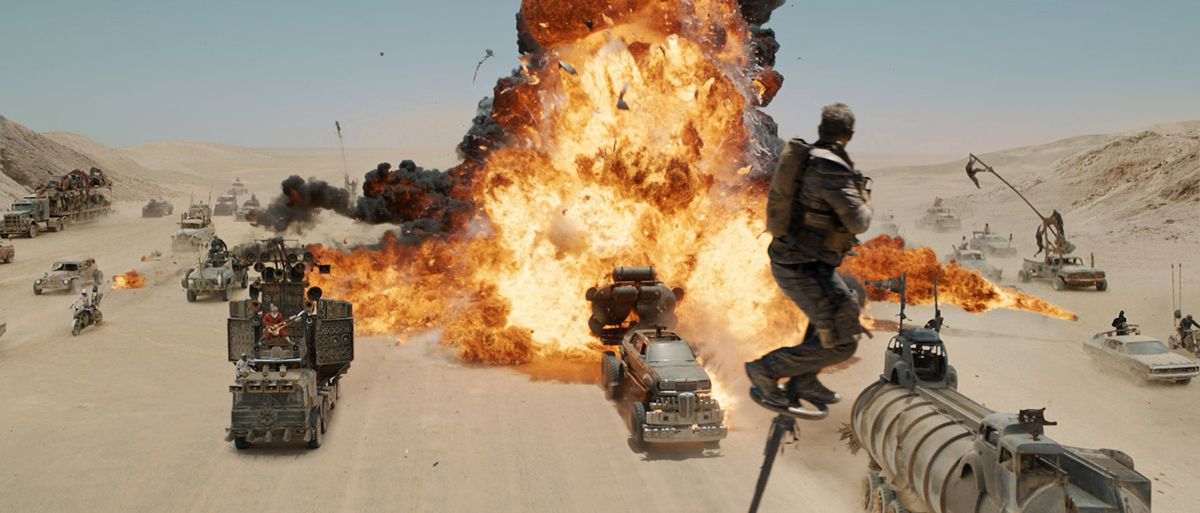
Shot from the movie.
“They drove a truck into the desert and, remotely controlling it, blew up. Removed it from various angles: with the help of cars and a helicopter. These are amazing special effects. According to the canons, the car, filled with explosives, blew up into the air - now it's just extraordinary. Once it was a cliche for all car chases. Our job was to refine the environment with these frames: the scene was originally shot on a completely flat desert area, and Jackson wanted the action to take place near the canyon, surrounded by cars and with Max in the foreground. We did not make any changes using computer graphics to the elements of the explosion itself. ”

The scene in the canyon and the real footage from the scene.
Work on the final stage of the chase was engaged in the studio The Third Floor PREVIS, as told by its head Glenn Burton. “The computer models of the cars created by PREVIS were the same shapes and sizes, which made us work in a limited space, as we needed to fit the actors in the frame and arrange the shooting equipment,” explains the studio artist, Shannon Justison. It was also important that the cars did not move, so as not to put the actors at risk. At the same time, PREVIS needed to be filmed in such a way that everything looked true.
Guitarist gets his

In one of the scenes of the film, an automobile blockage occurs in a ravine, which also includes a car with a guitar player, who for the most part of the film is suspended on cables.
The video was created on the plateaus of Namibia, where the work of actors and mechanisms was accompanied by a moving background, the addition of a virtual canyon, spectacular clashes of the Fighting Wagon and other cars. Surprisingly, all these twisted fragments of cars, metal and even a guitar that flew in front of the camera were not virtual special effects, everything was done "by hand".
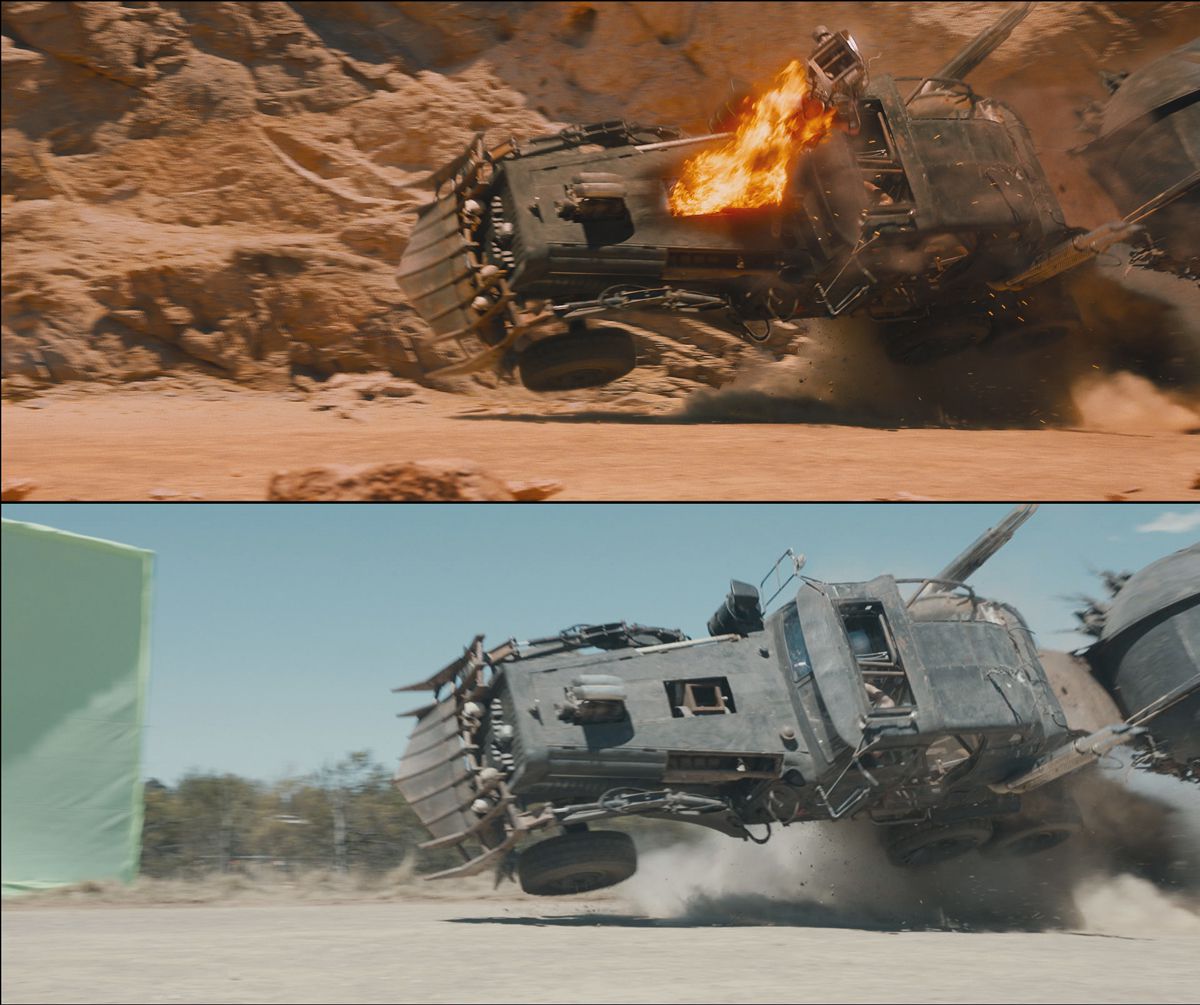
Cinema and reality.
“I think in the episode with the guitar we shot the best we could do,” says Jackson. “All these wires and fuel lines of flamethrowers broke, debris and particles of fuel flew away. It seemed to me that it was more realistic to get closer to the camera and then bounce back. We created for shooting a cradle in which the guitar player with his instrument hung. I suggested that if you pull it towards yourself and release it, it will return to its original position (note, the guitar is fixed on the cradle). We marked the place to which the cradle reaches and the camera was installed in it to shoot the episode. Thus, we had enough opportunities and attempts to capture this moment from the right angle. „
Even the steering wheel, which crashes after the guitar, was shot live, and not made using computer graphics. Jackson explains: “We shot with the help of a small rotating gimbal . In the end, George wanted the frame to fly right into the mouth of the skull on the steering wheel, but the resolution of the picture was not enough for this. Therefore, we tracked the rotation of the cardan gimbal and took several pictures in the required positions in high resolution. Later, we created the effect of stopping the rotation with the help of these images. Thus, even the moment with a shot of the frame on the mouth of the skull in the steering wheel was shot live.
Hand furyos
The character Charlize Theron, Furyos, appears quite early. She lost part of her left arm below the elbow and wears a metal prosthesis, and in one of the scenes where she fights Max, she only has to use a stump. To achieve the desired effect, Charlize wore a green sleeve during filming, so that the special effects team could then “paint over” the real arm and add the mechanical parts of the prosthesis where it was needed.
In fact, in terms of special effects, the work was not carried out very much, and in the frame one of the stars has a computer prosthesis. ”, Notes Wood. “It was much harder when Furios without a prosthesis, for example, in the scene of a fight with Max. On these frames only the stump is visible. When this episode was being shot, we asked Charlize to put on a green glove and not use her left hand. Subsequently, it was not necessary to design and draw a stump, which is difficult in itself. We studied the behavior of people with an amputated arm, but their muscles and tissues died off, and Charlize's character was cut off. All this does not look very nice and even scary. We needed to do everything so that the stump did not look too repulsive, but also to track the movement of the hand resting on the elbow. ”
Paint the sky
In many scenes of Fury Road, a full, seamless sky replacement is used.
The violent pace and complexity of filming in Namibia led to the fact that the background and the sky are not always visually consistent with each other from frame to frame. Plus, Miller wanted to give the picture its own style. This led to the fact that sometimes the sky had to be redrawn using color correction by Eric Hipp and an extensive library of sky images collected by Jackson around the world.
“Replacing the firmament is the fantastic thing that Eric brought into the picture,” says Jackson. “We really did not expect such a result. George thought that continuously connecting the color of the sky between different frames is not necessary, he just wanted to make the scenes more interesting in those places where he considered it useful. ”
Eric notes that Miller was adamant in his unwillingness to shoot typical, whitish post-apocalyptic landscapes. “During our work, two words were constantly spinning in our heads: a graphic novel,” says Eric. “We kept repeating it to ourselves. Whenever we had to color the sky, we sought to make it graphical, saturated, in order to promise this typical henbane. ”
Although the sequence of filming and not critical, but to shoot in an African country is always difficult. “I heard that one of the problems of filming in Namibia was morning foggy clouds catching up from the ocean,” says Hipp, “so first you get this whitish, foggy hours, and then, in the afternoon, the sky clears and becomes blue . It is very difficult to work in such differing conditions. It was here that the tinting of the sky came in handy, which allowed us to obtain the necessary picture instead of the whitish sky. ”
During his work at Baselight, Hipp used photographs from the film set and other places taken by Jackson. Also attracted his own collection of images collected by him around the world. “It's like a little piece of sky that I carry with me all the time,” says Hipp. “One of the most difficult parts of the film was working with the night scene. We wanted to use storm clouds with small gaps between them, but the original image was not so easy to find. I even went to the shore of the lake here in Toronto, in the hope that the photos of the cloudy sky that I take will be suitable for work. ”
In Baselight, Hipp used “a whole zoo of tools to make a replacement for the sky. At first I took some shots from the set and experimented on them, but the most difficult thing was to track the small details. In the end, I decided to go a simple way and replace the sky in a more convenient scene for this. Yes, this led to differences between the scenes, but the picture came to life. I understood that I could not do absolutely everything. Therefore, we resorted to the help of the visual effects team: they tracked small details faster than we did in Baselight, and spent less time on it. But, for the most part, we changed the background of the sky. ”
According to Eric, to work with some shots he had to track the position of the camera in the hands of the operator. For action, this does not pose any problems, but for other scenes he needed to rely on more accurate landmarks. “I wanted to explore the background of the footage, to find out what to cling to during the work,” says Hipp. “Sometimes it was a small space between the clouds or a small pebble in the background. Even if the landmark was in the foreground, I could compensate for the parallax in order to bring what is happening on the screen to what is happening on the background. ”
Traditional approaches were used by Hipp and his team where action took place against the sky. “Many times we were just very lucky because, for the most part, we had to change the morning, white sky,” Eric notes. “In this way, we got perfect shots for work. We could work with the sky and the modified light did not affect what was happening in the foreground, with the exception of some highlights that had to be added and eliminated the haze of the image. ”
Postgraduate
Understanding from the very beginning that the film would require great efforts to create special effects, Jackson involved in the post-processing of the sosbtvennuyu team. “For many years I have been inclined to think that when working on visual effects, we need a small team as part of the film crew in order to clearly formulate tasks for external contractors,” says Jackson. “Their task is to do everything possible to preserve in every frame all the effects needed by the editing director so that the film will be coherent and meaningful as a result.”
“We coped with the task perfectly well,” adds Jackson. “As a result, we got a very tight and solid installation, because it had all the necessary moments. Instead of letting everything go by itself, we sent to the companies that worked with us on the effects, clear TK, and they performed them exactly. Another advantage, which gives its own team for special effects - with plans in half a second-second, we could handle ourselves. With short plans it is much easier to work - you can not pay attention to many little things. So our team did many of them completely independently. ”
Source: https://habr.com/ru/post/367557/
All Articles